Thru Film: Triangular Desire
Thruple Trouble: Y Tu Mamá También and Erotic Bonds & Challengers and Erotic Rivalry
**listen to the voice-over to read along with me :)
René Girard (1923-2015), a French historian, literary critic, and social philosopher, discerned that desire is mimetic; meaning that desire is copied from something or someone else. I’ve talked about mimic theory, briefly, here. His theory is that desire is not dual-relational —but tri-relational because of the mimetic quality of desire. René Girard’s theory insists that “there is an irresistible impulse to desire what Others desire, in other words, to imitate the desires of others.”1 Summing René’s theory up as “Triangular desire”.
Specifically when two men desire one woman, “a man falls in love with the beloved not because he loves the other spontaneously, but because of a mimetic desire which is induced by a third party who loves the beloved in the first place.”2
From here on we’re exploring triangular desire only in instances that involve two (supposed) heterosexual men and one woman.
To analyze triangular desire through film we could look at numerous examples, but I’d like to focus on two movies I watched within the last few months, Challengers and Y tu mamá también (there will be spoilers). (And as much as I want to talk about other movies and the beautiful shots and great storytelling in both Challengers and Y tu mamá, this essay is already too long.)
Typically, within a love triangle, love is one-directional, with at least one line of desire reaching out unrequited. But I’d like to highlight instances, within the context of memetic triangular desire, where the third connecting line of desire is based on the homosocial bond between the men. In her 1985 book Between Men: English Literature and Male Homosocial Desire, Eve Sedgwick uses René’s theory of triangular desire as a jumping-off point for exploring homosociality within triangular desire.
“Homosocial” means the “social bonds between persons of the same sex”.3 She candidly clocks the term as an oxymoron, “obviously formed by analogy with ‘homosexual,’ and just as obviously meant to be distinguished from ‘homosexual.’”4 But Sedwick’s application of “homosocial desire,” specifically, in Between Men, uses the structure of desire “to hypothesize the potential unbrokenness of a continuum between homosocial and homosexual.”5 Simply put, she is making the case that although there are extremities relative to each end of the spectrum —homosociality and homosexuality are connected.
“Homosocial” can be applied to male bonding activities that may be inherently heterosexual and sometimes, simultaneously —and unconsciously— homoerotic. But, conversely, “homosocial” can also describe men's rights politics (not the misogynistic kind), of which is obviously not gay. (Fellas, is it gay to want your homie to have rights?) Sedgwick gives examples in chapter three involving homosocial activities —erotic and platonic— that strengthen and secure the masculine bond. One extreme example is the bond of cuckoldry6, while a less extreme example may be (these are my examples) going on the show “The Amazing Race”, or playing tennis together.
Luca Guadanino’s 2024 film Challengers tells the story of 3 tennis players in a love triangle. The film stars Zendaya as Tashi, Mike Fiast as Art, and Josh O’Connor as Patrick, (whom I once saw outside of Whole Foods on Houston in Manhattan). Art and Patrick were best friends who met as teens at tennis academy. Through the years after tennis academy they become an inseparable pair, at times conducting their actions, on and off the tennis court, almost synchronously. Though, synchronicity becomes a problem when they both crush on the same girl, Tashi Duncan. Patrick, who already has an affinity for Tashi, introduces Art to the tennis prodigy.
One night during a tournament, the summer before college, the boys manage to chat Tashi up at a party and invite her back to their hotel room. “We have beer,” they entice.
Eventually, Tashi shows up to their hotel room, the three of them talk, mostly the boys are drolling over her. She asks if the two have ever “you know?” implying if they’ve ever hooked up with each other.
“No no no,” says Art.
“Well...” Patrick says at the same time.
Patrick reveals he taught Art how to masturbate. They were in separate bunks and Patrick talked Art through it as they fantasized about the same girl.
I would call this the first erotic homosocial bond the boys experience. While we don’t know if this dual masturbation happened before or after the boys affirmed their status as BFFL (best friends for life), we do know that this experience bonded them on a level deeper than BFFL.
Similar examples of homoerotic bonding can be found in Alfonso Corzón’s Y tu mamá también. Recent high school graduates and best friends Tenoch played by Diego Luna, and Julio played by Gael García Bernal have a slow start to their summer as “bachelors”. A week after their girlfriends go on a trip abroad they spend their days at the country club pool, jerking off alongside each other, during the pool’s off hours.
While these activities are not explicitly homosexual, they are based in eroticism. Erotic homosocial bonding activities are not discussed as openly as platonic homosocial bonding. I think the clandestine nature of erotic homosocial bonding maintains and secures the bond between the two humans even further.
Social practices have remained divided by gender. Even though we know gender is illusionary, gender and gendered social roles are still an essential part of upholding regulatory heterosexuality. Two best girl friends kissing on the lips now and then wouldn’t be considered socially abnormal, but two best guy friends would. Homosocial bonding experiences between men can be intimate and nonsexual. It’s the experiences that lean more erotic that can secure an ultimate bond between men but also have the chance to break it. This type of erotic bonding experience is, generally, not something that women need to secure an ultimate bond. Women’s shared consciousness is typically inherent and can be expressed simply, by a look between two female strangers that asks “You good?” when a creepy guy is hitting on them or by being in the ladies' restroom together drunk. Sedgwick suggests that the need to differentiate between female homosocial and homosexual (H&H) bonds is irrelevant because society does not require differentiation. But male H&H bonds require distinguinshion so god forbid no one thinks they’re a homosexual.
Back in the hotel room in Challengers, Tashi invites the boys to sit on the bed with her, one boy on each side, she kisses Art first, then Patrick. Soon it's a passionate 3-way kiss. Then, in the heat of it all, Tashi removes herself from the kiss, watching the boys continue kissing each other and admiring the scene she so artfully set up. Then, she gets bored, breaks up their kiss, and leaves. One of the boys asks “Wait, can we get your number?” She tells them she’ll give her number to whoever wins the singles match Art and Patrick play against each other in the morning.
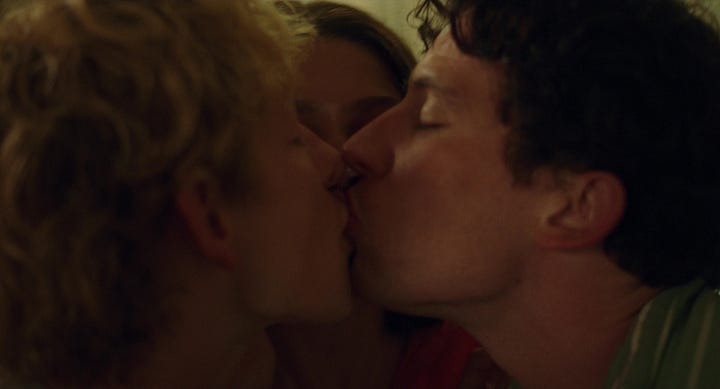
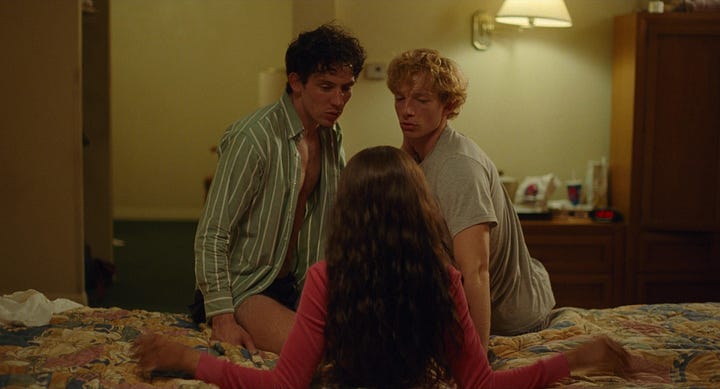
This begins the 13-year-long rivalry between the boys to win Tashi and tennis glory. The movie is told non-chronologically and actually begins with Art and Patrick in their 30s, at a challenger tournament in a fierce match against each other. The film then jumps around in time: back to the teenagers in the hotel room, Tashi and Patrick in a relationship during college, then Tashi and Art in a relationship, then Tashi and Patrick for another minute, then a homoerotic sauna meeting of Patrick and Art in their 30s, then finally we’re back to the challenger tournament. René implies, in his theory of triangular desire, that the subjects of the three-point relation “are anxious and hate each other because their desires are not properly recognized as their own.” By their 30s, Tashi and Art’s disdain for Patrick is stupendous —albeit dripping in sexual tension. The non-linear narrative7 and the hyped-up techno-pop soundtrack add to the film’s anxiety. Then, finally, by the end of the movie, we have all the information as to why the match, which we were introduced to at the beginning of the film, is pulsating with anxiety, pride, hate, entitlement, and a little bit of sexual tension.
When I started watching Y tu mamá también for the first time I thought “Oh, this is a boy movie”. While it is a boy movie, it’s also a coming-of-age movie that simultaneously makes an implicit but acute critique of class structures, globalization, and the national politics of Mexico.
The second act of the movie mostly takes place on the road. The boys are accompanied by Tenoch’s cousin’s wife, Louisa, on a road trip to the beach. Louisa decides to join the trip after a morose doctor’s visit and then deciding to leave her cheating husband.
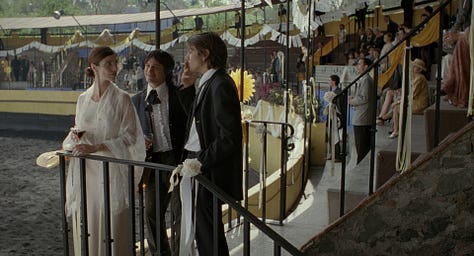

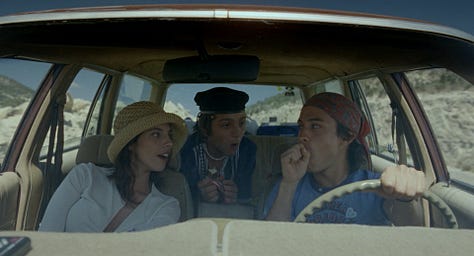
The story is so impactful in part due to the palpable bond between Tenoch and Julio —probably because Diego Luna and Gael García Benal are bffs in real life, think Ben Affleck and Matt Damon circa Good Will Hunting.
But the narrator captures their bond best:

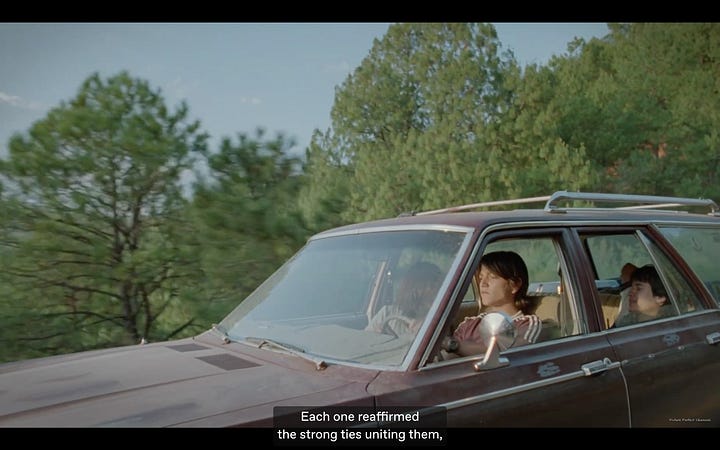


The trip to the beach is long and full of overnight stops, laughter, some fights, music, and a few detours due to car troubles. Within the passing landscape, we get a taste of the cultural climate in Mexico.
Enamored by Lousia’s Spanish beauty & trying to impress her, Julio and Tenoch brag about how they satisfy their girlfriends sexually, claiming the girls are “always screaming out for more”. Ultimately, Louisa tests their sexual knowledge and has sex with both of them. (She’s less than impressed.)
After a bunch of other stuff and some fighting, they finally make it to a beach. Towards the end of their trip, the boys find out both of them have been screwing each other's girlfriends, at first they're upset but then, on a tequila drunken night, they’re rejoiceful about the situation.
As they celebrate that they’re “cum brothers”, they cheer to their brotherhood; it seems as if their bond is stronger than ever now. They ask Louisa which boy is better at sex, who cums the quickest, and who made her feel the best; they insist on stoking rivalry.
Later that drunken night, the three of them have a sexual experience. Louisa gets most of the attention at first, one kissing her lips the other kissing her body, but then she lowers herself out of frame. It’s implied she’s performing oral sex because we don’t see her anymore. The camera focuses on Julio and Tenoch, their foreheads pressed up against each other, and then the boys start to kiss; putting the ultimate seal on their erotic bond of brotherhood.
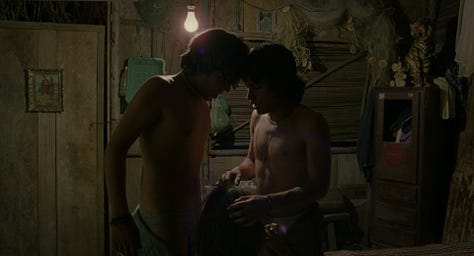

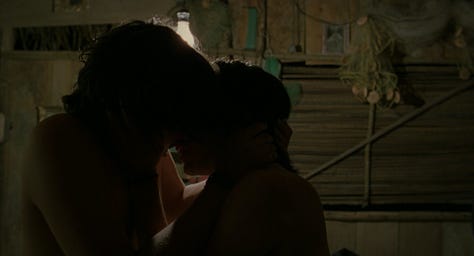
The boys wake up the next morning sleeping beside each other naked, no Louisa. They both jump up, possibly startled by the memories of the drunken night before. Julio and Tenoch’s journey has come to an end and they decide to go back to Mexico City, but Louisa continues to explore the neighboring beaches with a local family.
Stark reality hits after the erotic homosocial bonding between Tenoch and Julio, Curzón juxtaposes the beautiful Louisa swimming through the peaceful tamed waves, with the loud bustling sounds of Mexico City. There’s a time jump and the narrator brings us current on what’s happening politically in Mexico and socially with Julio and Tenoch: the ruling party has lost for the first time in 71 years and Julio and Tenoch have stopped hanging out as friends.
Months pass and the boys run into each other, they grab a coffee, it's awkward as hell. They talk a bit and catch up, Julio asks about Louisa. Before they leave there is an attempt at a hug, but it clumsily turns into a handshake. They say to each other:
“See you around?”
“Sure.”
Immediately, the narrator reveals that they will never see each other again. Sometimes, as we see here, the bonds of erotic homosociality can break a friendship beyond repair.
Whether the bond with her is successfully secured or not, the woman at the top of the desire triangle is a “currency that has no inherent value, but takes on value only in circulation among men”8. By the end of both Challengers and Y tu mamá también, it becomes clear that the beloved woman did not matter; she was just an object to win.
In René’s early book Deceit, Desire, and the Novel, he discovers, through the dissection of major European fiction, that what binds the triangle is rivalry and love. Furthermore, the erotic rivalry between the two male rivals (or two “challengers, if I may) is as equally influential as the desire for the beloved woman. René’s point was proven in Y tu mamá también: Louisa gets mad at the boys for their constant childish bickering. In a rageful storm off she says about the boys: “Typical men! Fighting like dogs and marking your territory when all you really want is to fuck each other.” Louisa can clock the erotic rivalry that has developed between the boys. In Challengers, this theme of erotic rivalry is unambiguously demonstrated through tennis: comments from Patrick about Tashi such as “I’d let her shove her racket up my ass”, the ultra-dramatic hyper-sexual grunts, and Tashi’s line that tennis is “a relationship” all sustain René’s discovery. I think that’s why people loved Challengers so much, it was easy to get, the themes translated well and young people loved it because they love gay shit. (Although I thought Challengers could have been gayer,)
I would say that Patrick and Art’s desire for Tashi, as a person, was left behind in their teenage years, however their desire for her as a tennis star is still there. The bond that Art and Patrick created in that hotel room as teenagers and the erotism that lingers between them is what fuels their desire, Tashi just becomes a socially appropriate outlet. By the end, Patrick doesn't really want Tashi, he wants to have sex with her, and he wants her tennis skills, but mostly he wants to destroy Art. And Art thinks he’s safe from Patrick’s rivalry because he won Tashi (married her), but Tashi wants Art to be a better tennis player and finally beat Patrick, therefore driving Art’s rivalry with Patrick.
And in Y tu mamá también, Louisa showed the boys that the continuum between homosociality and homosexual desire is indeed unbroken. Julio and Tenoch realize that being “cum brothers” exists on a spectrum of homosocial bonding and homosexual desire; i.e. the cool-socially-acceptable “straight” end vs the gay end of the “cum brothers” spectrum. In the last few minutes of the film, as the boys have their awkward coffee months later, Tenoch tells Julio that Louisa died and that she had cancer “all over her body...she knew the whole time.” While Luisa’s value as a character is only relevant in relation to the boys coming of age, her relation to director Alfonso Corzón’s camera is surely remembered amongst audiences; she moves with an intentionality that penetrates the camera, often locking eyes with it and breaking the 4th wall. And her advocacy for female sexual pleasure is championed (although might not resonate well enough for younger male viewers to actually heed her words). Louisa tested the bond between the boys and pushed it to its erotic limits, but unfortunately, their homosocial bond did not pass the homosexual test and their friendship was shattered.
Still a good movie tho…
Airaksinen, Timo. “René Girard and Mimetic Desire.” In Vagaries of Desire: A Collection of Philosophical Essays, 89–108. Brill, 2019. http://www.jstor.org/stable/10.1163/j.ctv2gjwthv.8.
Louis Lo. 2008. Male Jealousy : Literature and Film. London: Continuum. https://research-ebsco-com.proxy.uchicago.edu/linkprocessor/plink?id=06c54aec-cb0f-3c2e-9c5f-02cfcb8b7e42. Page 9
Eve Kosofsky Sedgwick. 2016. Between Men : English Literature and Male Homosocial Desire. New York: Columbia University Press.
Sedgwick
Sedgwick
you’re gonna have to look that one up on your own, mate
a story line told not in chronological order
Sedgwick Chapter 3





